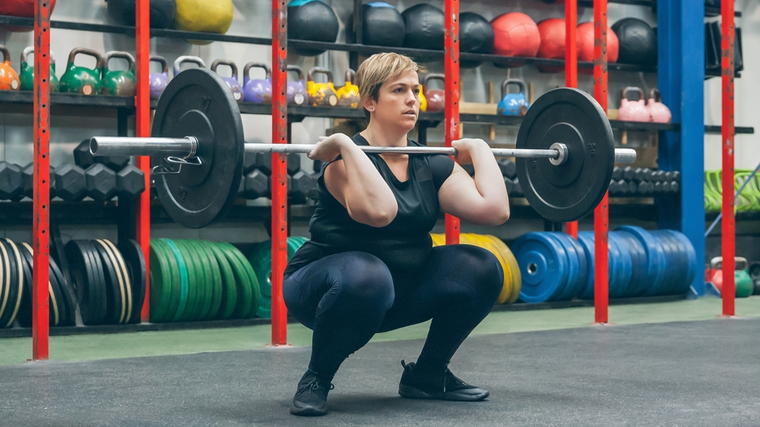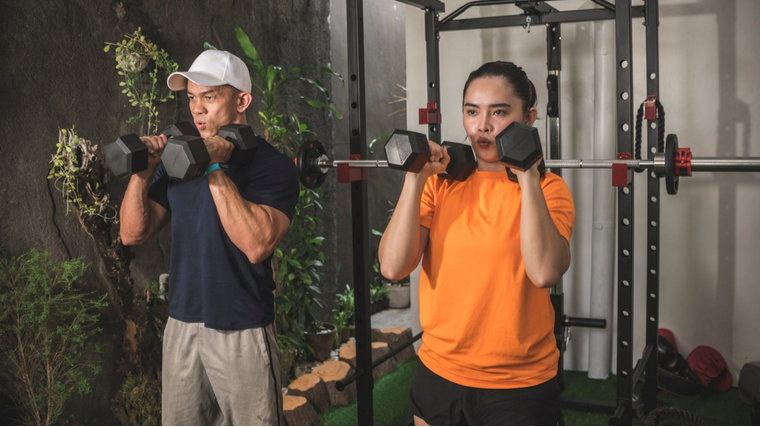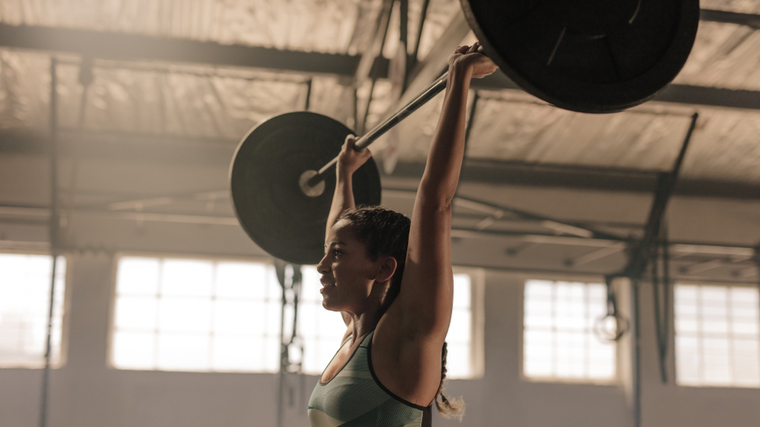One piece of equipment, one weight, one area — and go. That’s what you’ll be doing when you start a workout complex. Whether you use a barbell, dumbbell, kettlebell, or even battle ropes, a workout complex is all about maximizing your time and space while going as hard as you can.
It can be fun to move seamlessly between different pieces of equipment — think of a solid CrossFit workout that takes you from move to move. But anything from a crowded gym to limited equipment could prevent you from partaking in the strength-building, endurance-boosting sweat fest that is a workout complex.

When you need to get in an effective training session in a hurry, workout complexes might be just the thing you’re looking for. They’ll also come in handy if you’re looking for a brutal finisher to end your session on a high — and breathless — note. Whatever your training needs, you can likely design a workout complex that fits your goals.
What is a Workout Complex?
A workout complex has you perform back-to-back exercises with the same piece of equipment. You don’t change the weight or even put the implement down between moves and reps — you just flow from one movement to the next. This can take the form of a barbell complex, a dumbbell complex, or a kettlebell complex (sometimes referred to as a kettlebell flow).
The way you design any workout complex depends on your goals, but one general rule of thumb is that the exercises need to connect together in sequence. That means you likely won’t go from an overhead press directly to a bent-over row, because the end position of the press is so far away from the starting position of the row. Instead, you might go from a bent-over row to a clean & press.
How to Design a Workout Complex
At first glance, designing a workout complex seems a little, well, complex. But once you break it down into separate components, it can be fairly simple to create your own complex.
Step 1 — Determine Your Goal
Different training goals call for different workout complex designs. Are you looking to primarily improve your conditioning and work capacity? Maybe you want to use a barbell to perform high-intensity interval training (HIIT)-style workout. You might also be aiming to build your muscular endurance. Or you could just be looking to have as much fun as you can with your favorite piece of equipment. Determine your primary goal before making any other choices.
Step 2 — Choose Your Equipment
Do you have a passionate love affair with all things kettlebell? That alone might be enough reason to choose a particular piece of equipment. But your goals also influence this choice. If you want to improve your unilateral strength and iron out imbalances, dumbbells and kettlebells are a great choice. If you have more space available to you and want to lift as much weight as you can tolerate, a barbell may be your best bet.
Step 3 — Select Your Exercises
Most workout complexes are likely to recruit muscles from across your entire body. But for conditioning-related goals, you’ll want to choose moves that involve full-body power. On the other hand, if you’re focused on building muscle in a particular area, you might want to bias your exercise selection more toward your upper body or lower body.
Step 4 — Determine Your Exercise Order
Whatever exercises you choose, you need to put them in an order that makes sense for a complex. Remember, you won’t be putting the equipment down between exercises and reps, so each move has to flow into the next. You won’t be able to go right from a dumbbell thruster into a bent-over row, but you can go from a row to a clean to a thruster.
Step 5 — Choose Your Weight
The biggest factor to consider when selecting the right weight for your complex is your weakest link. This isn’t an insult to any of the lifts on your list — rather, it’s a practical assessment of your abilities. Can you deadlift a 40-pound dumbbell in your sleep, but only perform two reps of overhead presses with that weight? You’ll need to drop the weight accordingly so that your overhead press capacity doesn’t restrict you to only two overall reps. In this example, you’ll want to drop to at least 35 pounds — but potentially as low as 20 or 25 pounds if you want to work more on endurance and higher reps.
Sample Workout Complexes
Designing your own workout complex can be a bit easier when you have some examples to go on — and once you’ve tried a couple of complexes out to see what they can feel like. Here are a few examples you can use as is or modify according to your needs.
For Endurance
Since this workout complex is geared toward endurance, you’ll want to use significantly less weight than you would with a muscle-building or conditioning complex.

[Read More: The Best Upper Body Exercises and Workouts]
Make sure you’re still challenging yourself, but prioritize excellent form. This particular endurance complex is focused on building upper body endurance.
- Double Dumbbell Push-Up
- Double Dumbbell Clean
- Double Dumbbell Thruster
- Double Dumbbell Curl
- Double Dumbbell Overhead Press
- Repeat this flow without rest. Performing all five exercises in a row is one rep.
- Perform four to five reps with excellent form.
- Rest for 60 to 90 seconds and repeat for three more sets.
For Muscle
When you’re looking to primarily pack muscle onto your frame, you’ll want to aim for crisp, clean reps with moderately heavy weight.

This muscle-building workout complex is focused on your lower body, but will involve your whole body.
- Barbell Deadlift
- Barbell Bent-Over Row
- Barbell Muscle Clean
- Barbell Thruster
- Barbell Front Squat
- Repeat this flow without rest. Performing all five exercises in a row is one rep.
- Perform two to four reps with excellent form.
- Rest for 90 to 120 seconds and repeat for two or three more sets.
For Conditioning
While you can definitely use dumbbells and barbells for excellent conditioning workouts, kettlebells lend themselves well to power-based conditioning workouts.

Featuring explosive movements like swings and snatches, this workout complex is meant to push your limits.
- Double Kettlebell Snatch
- Double Kettlebell Swing
- Double Kettlebell Dead Stop Swing
- Double Kettlebell Clean
- Double Kettlebell Push Press
- Repeat this flow without rest. Performing all five exercises in a row is one rep.
- Perform three to four reps with excellent form.
- Rest for 90 to 120 seconds and repeat for three or four more sets.
Benefits of Workout Complexes
Workout complexes aren’t actually all that complex. Once you get the hang of how the moves flow together, they can be pretty simple to perform. After all, you only need one weight, one piece of equipment, and one (small) area to work in. But the benefits are many — and, one might even say, complex.
Make the Most of Your Time and Space
Maybe you have no choice but to hit the gym at the same time everyone else does. If you hate when the gym is crowded and want to get in and out as quickly as possible, a workout complex can help you do just that. That’s because these complexes are an incredibly efficient way to spend your time. All you have to do is grab a single piece of equipment and flow through a few sets of a few reps each. Although that doesn’t seem like a lot of volume, you’re packing multiple exercises — without rest — into every single rep. You’re likely to be completely fatigued and ready to hit the showers after 15 minutes.

Especially if you opt for using a kettlebell or dumbbell — instead of a six-foot barbell — you don’t need a lot of space for workout complexes, either. For the most part, you can perform kettlebell and dumbbell complexes on an area no larger than the yoga mat in your living room.
Increase Work Capacity
With workout complexes, you’ll be getting an extremely high level of work done in a very short period of time — AKA, improving your work capacity. Every single rep involves at least three different exercises — often more like four or five — and you’ll ideally perform two or three reps per set. Throughout your entire set, the idea is to flow from exercise to exercise with no rest. You’ll also be involving your full body in each rep.
Having a higher work capacity will help you crank out more reps and recover more efficiently. That’s a great recipe for improving your strength training overall.
Improve Grip Strength
No matter which implement you choose, the goal of a workout complex is to move through each exercise without stopping. You won’t put the weight down as you flow from move to move and rep to rep. That means that, in a lot of cases, your grip strength may actually become the limiting factor in how many reps you can pull off with good form.
That’s a good thing for developing your grip strength. By keeping your fingers, wrists, and forearms under tension for so long, you’ll be increasing your muscle-building potential and strength in areas that often don’t get enough stimulation.
Get Stronger
You won’t be lifting the heaviest weights possible with a workout complex, but you’ll be preparing your body to do so. Increased work capacity and better grip strength will help you lift heavier when it’s time comes to go hard. The mental toughness you develop from being able to push through rep after rep can also serve as effective mental preparation for big max attempts.
Keep it Complex
Looking for a way to get a full-body workout in a short period of time? You don’t need to look any further than workout complexes. Don’t be intimidated by what they’re called — workout complexes are actually pretty simple once you get the hang of them. All you have to do is grab a single piece of equipment, gather all your mental and physical stamina, and get after it. The gains will certainly follow.
Featured Image: David Pereiras / Shutterstock